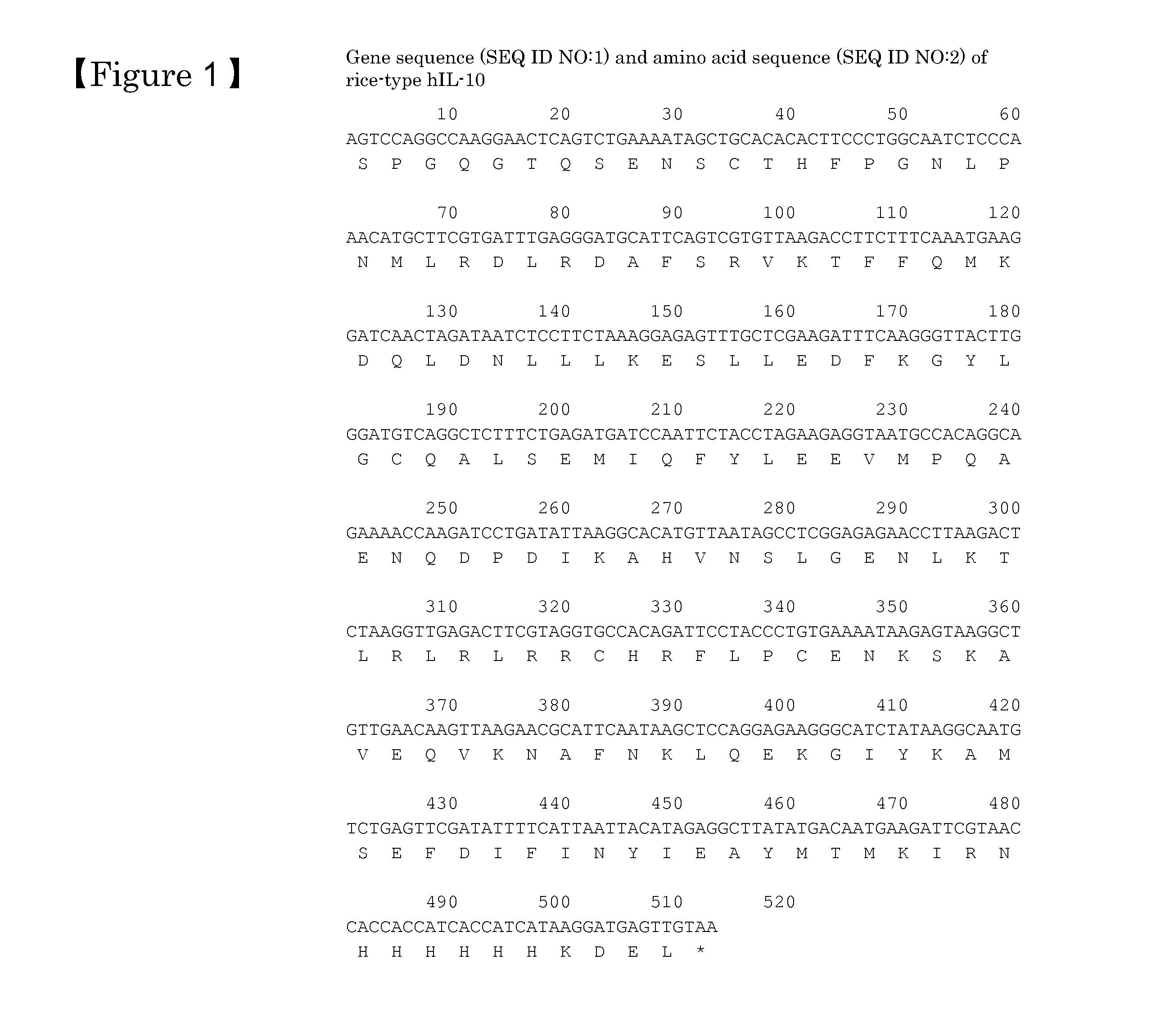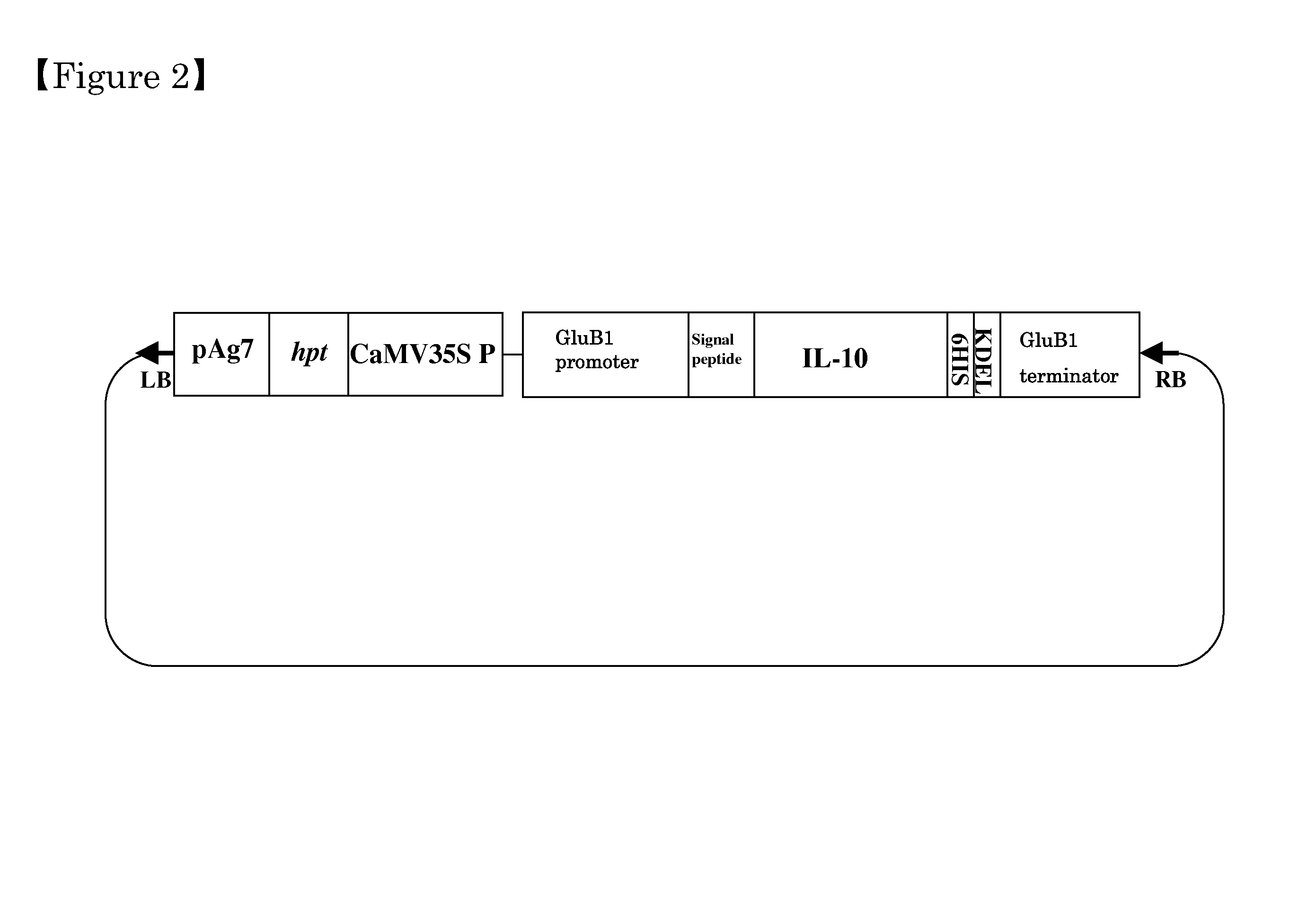Method for extraction and purification of recombinant proteins from transgenic plants
a technology of recombinant proteins and purification methods, which is applied in the field of extraction and purification of recombinant proteins from transgenic plants, can solve the problems of inability to stably exist monomer only by itself, become enormously expensive to manufacture a large scale of recombinant proteins, and inevitably a serious risk of contamination by pathogens such as human-infectious viruses
- Summary
- Abstract
- Description
- Claims
- Application Information
AI Technical Summary
Benefits of technology
Problems solved by technology
Method used
Image
Examples
example 1
Generation of Transgenic Rice Plants Expressing Recombinant hIL-10
[0078]In order to express recombinant hIL-10 in rice seeds, vectors expressing recombinant genes using a glutelin promoter were used. (Yang, et al., Plant Biotechnol. J. 5, 815-26. (2007); Kokai Tokkyo Koho JP 2008-109946). The secretion signal is removed from hIL-10 gene based on the genetic sequencing information of hIL-10 (Gene Bank registration number: BC 104252), and the codon of hIL-10 was converted to a rice-type codon according to the codon frequency of rice seed proteins. The resulting novel nucleotide sequence (SEQ ID NO: 1) of the hIL-10 gene, wherein the codon is converted to a rice-type codon, and the corresponding amino acid sequence (SEQ ID NO: 2) are shown in FIG. 1. The 6His tag and the endoplasmic reticulum retention signal (KDEL), which increases recombinant protein accumulation in rice seeds (Yang, et al., Plant Biotechnol. J. 5, 815-826 (2007)), are attached to the 3′ terminus of the nucleotide se...
example 2
Pre-Extraction and Extraction of Recombinant hIL-10 Using Extraction Buffer Solution Containing Reducing Agents and Surfactants
[0081](1) Pre-Extraction of Contaminated Materials Other than Recombinant hIL-10
[0082]The rice seeds containing recombinant HIL-10 were collected from the transgenic rice plants generated in EXAMPLE 1. A 50 g of rice seeds was hulled to remove the hulls thereof and pulverized with an electric mill (SAMAP Corporation, F-50) to a fine powder thereof. To remove bran and germ and to collect albumen portion the pulverized rice seeds were screened at an aperture size of 355 μm. A 40 g of the resulting pulverized rice seeds was added to 800 mL of extraction buffer solution consisting of 50 mM Tris buffer solution (Tris-HCl, pH 7.4) and 0.5 M NaCl in a 1 L flask, and extracted overnight at 4° C. at 400 rpm using a magnetic stirrer. Contaminated materials including seed proteins other than recombinant hIL-10 in the pulverized rice seeds were extracted (FIGS. 3 and 4)...
example 3
Purification of Recombinant hIL-10
[0084](1) First Purification of Recombinant hIL-10 by Ni Affinity Column
[0085]The resulting recombinant hIL-10 in the extraction buffer solution prepared in EXAMPLE 2 was purified by Histidine tag affinity column chromatography using HisTrap FF column 5 mL (GE Healthcare: AKTA prime plus) (Ni Affinity Column), which was performed by a general and commonly known purification method in this field. The recombinant hIL-10 was eluted by a stepwise elution method using a starting buffer solution (50 mM Tris-HCl (pH 7.4), 0.5 M NaCL, and 20 mM imidazole), an elution buffer solution (50 mM Tris-HCl (pH7.4), 0.5 M NaCl, and 0.4 M imidazole) (FIG. 7).
(2) Second Purification of Recombinant hIL-10 by Ni Affinity Column
[0086]The eluted fluid obtained from the first purification of recombinant hIL-10 by Ni affinity column was precipitated by adding acetone thereto. The resulting precipitate was dissolved in a starting buffer solution (20 mM Na phosphate (pH 7.4),...
PUM
| Property | Measurement | Unit |
|---|---|---|
| Mass | aaaaa | aaaaa |
| Mass | aaaaa | aaaaa |
| Mass | aaaaa | aaaaa |
Abstract
Description
Claims
Application Information
 Login to View More
Login to View More - R&D
- Intellectual Property
- Life Sciences
- Materials
- Tech Scout
- Unparalleled Data Quality
- Higher Quality Content
- 60% Fewer Hallucinations
Browse by: Latest US Patents, China's latest patents, Technical Efficacy Thesaurus, Application Domain, Technology Topic, Popular Technical Reports.
© 2025 PatSnap. All rights reserved.Legal|Privacy policy|Modern Slavery Act Transparency Statement|Sitemap|About US| Contact US: help@patsnap.com



